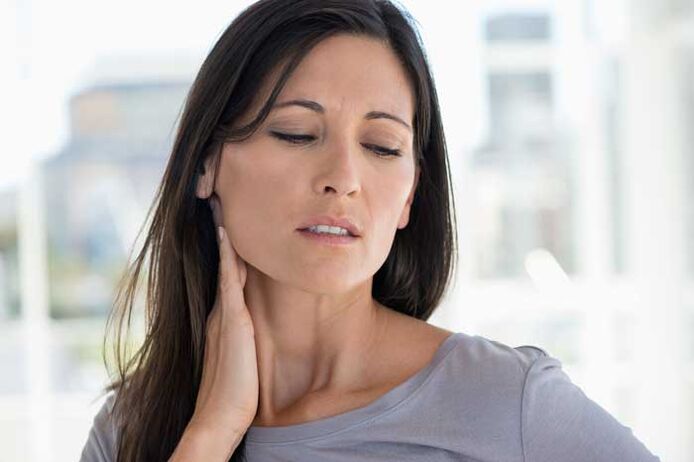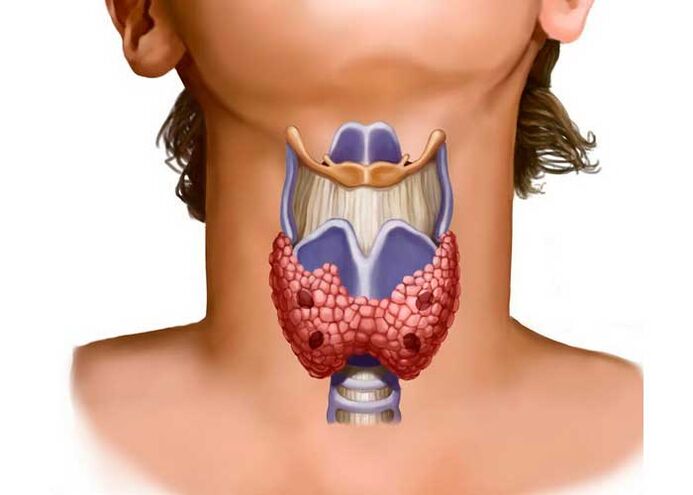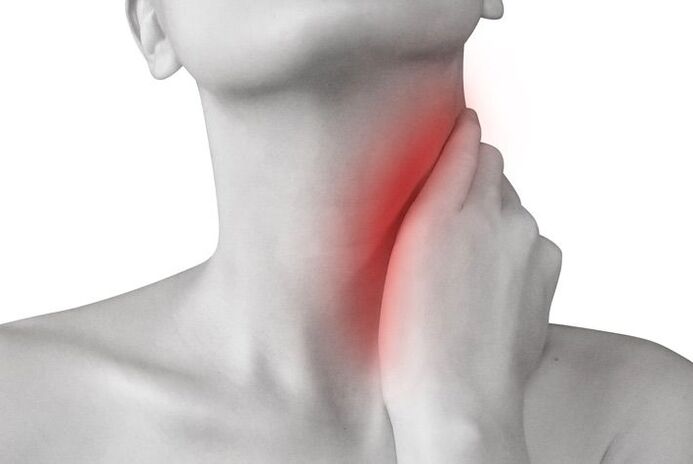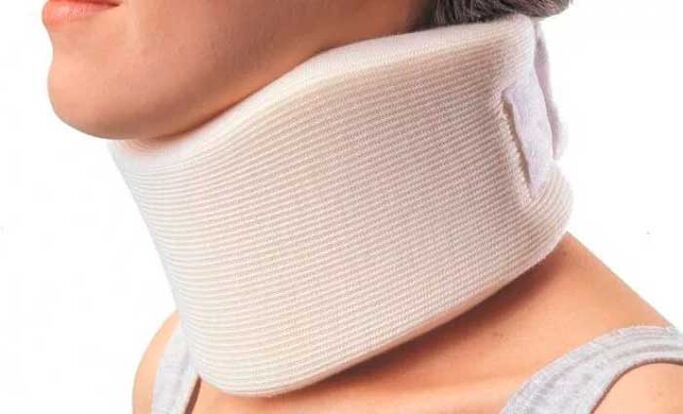
The neck is considered to be the part that determines the life of the human body. Major blood arteries, veins, capillaries and nerve fibers pass through it, forcing the whole body to work fully. Blood vessels supply the brain with the delivery of nutrients and oxygen, without which the most important organs of the nervous system cannot function normally. If someone is experiencing neck pain, you need to find the cause of the disorder and, as far as possible, eliminate it.
Kind of neck pain
Pain syndromes are divided into two main groups:
- Cervicalgia (lumbago) - frequent, with varying strength and dynamics, spreading to the shoulders and beyond. Often it has an interesting and painful character. The cause is a painful spasm of the neck muscles.
- Cervicago is a sharp pain that occurs unexpectedly during an unexpected sharp round of the head, staying long in an uncomfortable position. At the same time, one cannot freely turn his neck, nodding in severe pain. "Shoots" on, shoulders, chest, hands. This pain is associated with the effect of stimulation on the nerve endings that run near the brain.
The cause of the disturbance
Often patients experience cervical pain. Sometimes cramps are given in the back as a result of inadvertent head movements. Occasionally, there is discomfort in the occipital area. It is especially unpleasant when pain syndrome appears in the morning due to uncomfortable posture during sleep.
With the encounter of unfavorable conditions, pain can arise as a result of untreated infectious diseases. They are so unbearable that it is impossible to figure out the cause of their occurrence.
Neck pain occurs for a variety of reasons:
- Not specific.
- Vertebrogenic.
- In case of damage to internal organs.
- With the development of oncological formation of benign and malignant nature.
- In the event of an injury.
- With inflammation of bone tissue (subacute osteomyelitis, purulent lymphadenitis, spinal paralysis, meningitis, exacerbated thyroiditis).
The reason is not specific

Patients often have to experience nonspecific pain. They arise in response to overstrain of the cervical muscles and are considered a natural response of the body. Usually, this feeling appears when a person has been lying in an uncomfortable position for a long time or working too much physically.
Neck pain due to a serious load that is dynamic in nature. To get rid of unpleasant sensations, the body must rest well. This pain is not too strong, does not last long and disappears on its own without the need for special treatment.
When overload persists, physiological pain takes a chronic form - a degenerative -dystrophic process begins. Harmful factors should be eliminated immediately when alarming symptoms appear, and not wait for the progression of the disease.
Statistical causes of pain can be:
- Wrong position during sleep.
- Frequent head movements.
- High compact cushions.
Causes of vertebrae

Dysfunction of the cervical vertebrae, discs, the joints that connect them, ligaments and muscles is the answer to the question of why the neck hurts. When pain syndrome is constantly observed, degenerative-dystrophic disease of the spine is recorded in such patients during X-ray examination. The neck is prone to this disease because of its anatomical structure:
- The neck joint is very mobile.
- The spine has a very fragile structure and is small in size.
- They bear a very large load at all times, supporting the skull.
- Neurovascular fibers are located inside the vertebrae.
Degenerative-dystrophic pathologies include:
- Osteochondrosis.
- Kyphosis.
- Spondylolisthesis (listez).
- Lordosis.
- Spondylopathy.
- Spinal stenosis.
- Intervertebral hernia. With him, the neck hurts, especially on one side.
With such disorders, complications may occur in the form of torticollis, disc protrusion, compression of spinal cord tissue, development of sciatica, spinal deformities, persistent headaches, dizziness, and tinnitus.
Internal problems

Neck pain that occurs in the front is associated with damage to the thyroid gland. They usually manifest themselves in inflammatory lesions of the glands (thyroiditis), of an acute, subacute, chronic or autoimmune nature. This disorder is indicated by:
- Increased body temperature.
- Lethargy, drowsiness.
- Redness, possibly swelling of the skin on the front of the neck.
- Choking, difficulty swallowing.
Thyroiditis causes systemic throbbing pain. It grows when swallowing, turning the head, probing the glands.
Unexpected neck pain from the side indicates inflammation of the lymph nodes in ENT organ disease. Provocateurs of this situation can:
- ENT diseases of different nature (pharyngitis, laryngitis, sinusitis, otitis media).
- Dental caries.
- Gum disease.
- Retropharyngeal abscess.
- Infectious diseases.
The neck may swell significantly, losing its shape. The temperature rises rapidly, symptoms of the development of the underlying disease are observed.
Development of oncological neoplasms

Neck pain triggers cancer of the vertebral tissues, blood vessels and internal organs located in the neck. Spinal tumors can:
- Primary (mesenchymal chondrosarcoma, osbolithosarcoma, lymphangioma).
- Secondary (myeloma, lymphogranulomotosis).
It happens that the cause of neck pain lies in tumors of the spinal cord and nerve fibers.
Neck injuries

The spine in the neck area is quite fragile and vulnerable, which means it is prone to injuries of varying severity, such as:
- Fractures, bumps, bruises.
- Dislocation, subluxation.
- Sprains, torn ligaments and muscles.
- Torn fragments of the intervertebral disc.
- Extensive hematoma, bruising.
- Compression of spinal cord tissue.
Neck injuries are very dangerous. This area contains important centers that allow the spinal cord to function. Brain affection at levels 1 and 2 segments of the cervical vertebrae leads to immediate death. Injuries to the lower back can cause a person to be unable to feel their body under the neck and move. Trauma to the 7th and 8th vertebrae affects the lower part of the foot.
Inflammation of the bones
The cervical spine can become inflamed. Often they are in the nature of systemic connective tissue diseases:
- Limban-Sachs disease.
- Rheumatoid arthritis.
- Periarteritis nodosa.
- Wagner's disease.
- MCTD (Sharpe syndrome).
- Progressive systemic sclerosis.
- Vasculitis.
- Ankylosing spondylitis
When a patient’s neck is sore and sore, the cause is often associated with ankylosing spondylitis (ankylosing spondylitis). In this case, the vertebral joints become inflamed, deformed, and complete immobility of the cervical vertebrae occurs.
Neck pain in children

In children, unlike adults, cervical pain is hidden not in the defeat of vertebral tissues and structures, but in:
- Lymphadenopathy.
- Bone tuberculosis.
- Zaushnitsa (pig).
- Meningitis.
- Tetanus.
- Pneumonia.
- Retropharyngeal abscess.
- Rheumatic diseases (polyarthritis, oligoarthritis).
When a child experiences neck pain and discomfort, it cannot be ignored. Consultation with a pediatrician is required, as the cause of this condition can be very serious.
Therapy and diagnostics

You can free yourself completely from pain by identifying the cause. You can relieve the painful sensation of symptoms with the following medications:
- Nonsteroidal analgesic and anti-inflammatory drugs.
- Muscle relaxants that relieve cramps and muscle spasms.
- Glucocorticoid hormone agents. They are used to enhance the effect of painkillers.
- Chondroprotectors are used for a long time to restore cartilage tissue and stop its breakdown process.
- Decongestants, anticonvulsants, antidepressants, vitamin therapy to relieve chronic pain.
An experienced professional should be involved in treating the disorder. First you need to see a therapist. He will, according to the complaint, assess the general condition of the patient, tell you why the neck hurts, how to treat the pathology, what annoying factors must be avoided.
Depending on the cause of the disease, the therapist will recommend visiting a narrow specialist such as:
- Rheumatologist.
- Orthopedic Specialist.
- Trauma specialist.
- Neurologist.
- Massage therapist, chiropractor.
- Physiotherapist.
For cervical pain, such research methods are defined as:
- General blood analysis.
- Determination of ESR.
- Screening for rheumatoid factors.
- X-ray of the spine.
- CT and MRI (computed and magnetic resonance imaging) of the spine.
When an adult or child experiences pain in the neck, this may be a sign of osteochondrosis, meningitis, as a result of stress, or a side effect of taking certain medications. Doctors need to determine exactly why their patients are experiencing persistent neck pain.
If, after examination, it is revealed that inflammation of the lymph nodes has been the main cause of neck pain, they are prescribed:
- UHF.
- Massage the back and base of the skull.
- Rehabilitation gymnastics.
- Medications.
You cannot ignore this disease. In the final stages of its development, surgical intervention will be required to open the lymph nodes and clear them of accumulated pus.
Non -drug treatment

Complex therapy strengthens the cervical muscles, helps relieve cramps, makes them flexible and elastic, improves blood flow, restores the mobility of the neck vertebrae, prevents exacerbation and progression of the disease. To do this, use:
- Physiotherapy.
- Acupressure.
- Manual therapy.
- Physiotherapy.
- Wear a splint collar.
- Spa treatments.
- Acupuncture.
- Spinal column attraction.
In the acute period, physical therapy, massage, gymnastics are not used until the pain stops. Modern methods of physiotherapy allow you to achieve successful results without strong medications and surgical intervention. To:
- Secure hardware system (Elgos).
- Laser handle therapy.
- Electrophoresis.
Doctors advise patients what to do when their neck hurts. Need:
- Sit upright, do not bend over when reading, writing, eating.
- The work chair must have an ergonomic backrest.
- Monitor your posture while walking.
- Sleep on a small orthopedic pillow.
- Rub the neck with an ointment or gel prescribed with analgesic effect three times a day.
- Do your own massage to relieve pain.
For severe neck pain or pain, you should not:
- Throw your head back sharply.
- Turn frequently to the affected part.
- Keep working, reading, writing in a bent position.
- Abuse of wearing a shutter collar.
- Sleep on a large, high pillow.
What to do if you blow your neck

Severe pain in the back of the neck, accompanied by muscle inflammation, occurs with prolonged exposure to cold air currents. People sometimes complain that they have blown their necks. Doctors call this condition myositis. At the same time, the patient can not calmly turn around, tilt, throw his head back, his neck is very sore.
The doctor will help you quickly and effectively get rid of this disease. Before visiting his office, there are a few steps you can take to relieve discomfort and pain:
- The painful area must be lubricated with a warming ointment (usually such an ointment smells unpleasant and causes a burning sensation on the skin).
- Massage the neck with smooth light movements.
- Apply dry heat to the inflamed area (wrap yourself with a wool scarf, attach a terry towel).
- Try not to make sudden movements.
Do not take painkillers without consulting a doctor. Only a doctor can prescribe them and determine the dose.
Treatment of osteochondrosis of the neck
Neck problems with osteochondrosis are more common than with the lower back. Often, the lower segment of the vertebrae is affected-5-6 or 6-7. The pain manifests itself in the back, shoots in the neck on the left, it is especially felt during exacerbations.
Osteochondrosis is a chronic disease, indicated by periodic deterioration, which can have vague symptoms for a long time. For treatment, patients are prescribed:
- Physiotherapy (hydrotherapy is very effective for this disease).
- Analgesic.
- Take non-steroidal anti-inflammatory drugs. They are recommended to be taken within 3 weeks. Then the patient's condition is assessed and a decision is made on the further use of drugs in this group.
- Special rehabilitation gymnastics.
- Manual therapy.
- Along with conservative medicine, treatment with folk remedies is welcome: lotions, compresses, decoctions, infusions, ointments and homemade creams.
If it is possible to get rid of osteochondrosis in the first stage, one should not forget about prevention to prevent recurrence of the disease.
Folk recipes

Neck pain can be eliminated using folk recipes:
- The absorption of a series perfectly relieves inflammation. For medicine, 1 tbsp is needed. l. dried raw materials, filled with a glass of boiling water. After 3-4 hours of infusion and filtration, the drug can be taken half a glass before meals.
- An effective ointment made from a mixture of St. John's wort. John, pine buds, eucalyptus leaves, mint, and snake root. All components are ground into a powder. Then 100 ml of boiling water is poured and boiled for 4-5 minutes. 75 g of melted butter (vegetable or butter can be used) is gradually added to the soup. The ointment is applied after it hardens. Store in the refrigerator.
- In the same way, you can prepare the ointment with king banana, hops, burdock, lavender, marshmallows, dandelions, yarrow.
- An excellent healing composition is possessed by an ointment based on dandelion root, birch buds, sown coriander.
Surgical treatment is used in cases of emergency and for severe symptoms - if complications of vertebral disease develop, the patient experiences severe chronic pain that cannot be eliminated by conservative treatment for six months. Surgery to relieve neck pain carries a very large risk. Therefore, for a start, all available treatment methods should be taken to combat the disease.






















